G. Ryan Faith is a Washington-based space policy analyst and writer who has worked for the House Science Committee, the Space Foundation and the Center for Strategic and International Studies. He was the defense and security editor at VICE Media from 2013-2016. He is currently writing a dissertation on American public attitudes toward space prior to World War II.
Strategists and planners at NASA are mulling over questions of tempo for future human expeditions to the moon. Should Artemis involve a yearly campaign of smaller missions or consolidate expeditions, launching more ambitious (and, therefore, sporadic) efforts less often?
Exploration, at its core, is about making the unknown a little more familiar and comfortable. Whether a destination becomes more meaningful as a scientific site, historical landmark, or economic opportunity, exploration involves integrating a distant place into our larger human world. The first human voyage into space, Yuri Gagarin’s 1961 Vostok flight, captured the world’s headlines and imagination. Over the course of less than two hours, Gagarin proved that the immense, terrifying void above our Earthly home had become a place that we humans, the merely mortal, could now dare to tread. Sixty-two years later, SpaceX and NASA can bring together four astronauts from all over the world and fly them to the immense International Space Station, and the feat attracts little attention beyond the press release. Low Earth orbit is now less exotic and more familiar. After more than half a century of work, humans have made it a place for people to visit and work.
As clearly shown by the collapse of interest in human lunar exploration after the dazzling Apollo 11 mission, the public sometimes loses interest in increasingly ordinary expeditions to ever-more-familiar destinations. That lesson was highlighted again by the Space Shuttle program’s clear demonstration that without purpose, routine renders ongoing missions boring and mundane even if they become no easier or more routine. This is one of the central paradoxes that define space exploration. The first expeditions are animated by curiosity and excitement. Subsequent expeditions to that once-captivating destination become trivial and tedious even as the journey remains every bit as challenging and perilous.
But human nature also suggests a solution. Throughout history, people have turned to ritual to invest the regular and otherwise ordinary with meaning and purpose. Rituals can renew a sense of wonder and awe, recharging and revitalizing the habitual.
This is where the conversation turns back to mission tempo. The rhythmic yearly passage of time is deeply ingrained into human culture, second in importance only to the day/night cycle. Passing years mark an entirely familiar passage and celebration of life’s most important events. That holidays, anniversaries, and birthdays are celebrated annually seems so obvious that it escapes mention.
Pomp and Happenstance
Doing something every other year (or so) is not acting at a natural, customary pace. Even our language seems to rebel at the idea. Biennial? Biannual? Semiannual? All just different, mutually confusing ways that people struggle in everyday conversation to articulate the idea of “not once per year.” If the history of fickle human interest is any guide, a planned biennial pace will, in time, see launches drift from every 24 months to every 36 or so, eventually sputtering off into quiet irrelevance. If planners want to forestall that slowing rhythm of decay, perhaps instead of naming them numerically, Artemis missions should be named after the relevant session of Congress. Then, perhaps, Congress or someone else on a biennial cycle might remember that America has committed to an ongoing campaign of lunar expeditions.
But launching every year around the same time? This is a tremendous opportunity for NASA to renew its promise to the world and the future. Of course, weather and launch windows would never conspire to let Artemis planners freely pick a specific day, years in advance. It is, however, within NASA’s considerable planning and operational abilities to launch at roughly the same time each year. Perhaps the week of Memorial Day? Can NASA mark that friendly, cheerful celebration of summer’s arrival with the spectacle of launching those daring few into the heavens, ready to set foot on another world? If NASA wants the public to celebrate space exploration, then there is no better way to do it than to make a regular holiday of it. And there is no easier way to make it a regular holiday than by starting with a public holiday celebrated nationally.
Commitment and Conviction
Launching the same time every year allows America to reaffirm that its promise to send humanity to the moon is a matter of commitment and conviction. Without that promise, epic voyages turn into a kind of strange, sporadic—almost furtive—sneaking. Missions will start to slip and slide around the planning calendar with awkward grace, surrounded by a haze of uncertainty. With annual expeditions, the United States—through the hard work of NASA—can visibly recommit itself every year (somewhere around the time of spring break and graduation) to sending four of the best and brightest and most dedicated people it can find on a voyage, a pilgrimage even, to climb into the sea of night atop a blinding pillar of flame to dwell, at least for a while, in the celestial firmament.
Rendering each launch as a celebration recommitting to hope for a brighter future can fundamentally shape how lunar exploration sparks and inspires the national, even global imagination. Springtime is already the season of hope, growth, and rebirth—why not let that set the tone for the future of exploration? Imagine if every student, from grade school to college, could count on a regular springtime Artemis lunar mission as a symbolic promise that the country is renewing its commitment to discovery, science, and a brighter future for all. Every fall semester could start with a review of what those brave heroes we sent into the void—those few who lived and worked for a time on the bright, silvery moon—have learned from all their voyaging and brought back to Earth to share with a world that watched them expectantly from afar.
What about the cost? It’s entirely possible that appropriators feel it is not worth allocating a single dollar per American per week for such a dramatic, profound commitment to the future and act of public diplomacy. Perhaps plans to reduce SLS launch costs from exorbitant to merely expensive are overambitious. Or, per the recommendation of the recent NASA OIG report, is competition the way to go? Can NASA sustain an annual tempo by mixing SLS and commercial launch? Or mixing surface sorties with south polar infrastructure building? Congress, the White House, and NASA have a rare, fleeting chance to make a dramatic, bold promise about humanity’s future on behalf of their country. Or will our leaders choose the quieter, safer path, laying the groundwork for disenchantment and eventual cancellation?
Stripped to its core, space exploration is about an appeal to hope and a brighter future. Whether or not any specific expedition produces a stunning triumph of science or engineering—even art or culture—NASA must propose to the world that the ongoing exploration fundamentally makes our world a little bit better. In the face of the essential, irreducible uncertainty of exploration, NASA can weave hope for a better future into our culture by ritualizing the most visceral, fundamental, and visible phenomenon of space exploration: Launch.
With the end of every human mission of space exploration, whether safe or tragic, there is always the lingering, unspoken question about whether we can hope to see another such miracle again. We can create in culture and custom a world in which the response will always be “Next spring, when the flowers are in bloom,” or a world in which it’s maybe 24 or 31 or 39 months… or whenever the mood next strikes? Establishing Artemis as an off-again, on-again, episodic flight of fancy will give rise to a program that will forever carry around the unmistakable scent of inevitable obsolescence. If America is going to promise the moon to our world, then it should be proud of its commitment. Make Artemis into an annual celebration of hope for whatever bright promises the future may someday hold.
Related











